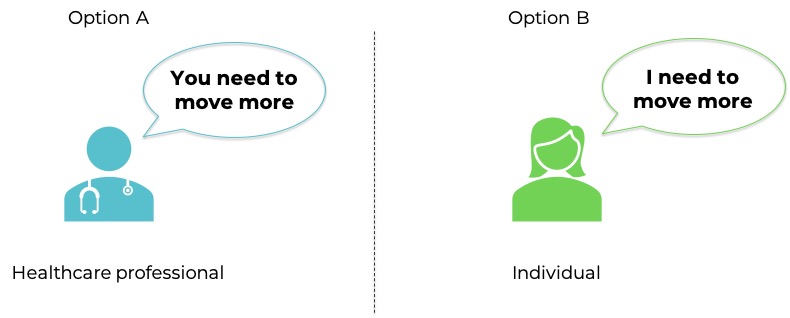Have you ever done the opposite of what someone has told you to do, even though what they said was sensible? If you have, then you are normal – people generally favour their autonomy rather than comply with changes imposed upon them by others. It’s called reactance, and whilst children have more of it than others, we all have this tendency. This includes our patients when we tell them to change so the prescribing movement resources are set out in a framework to help frame important messages an evidence on physical activity in language that enables them to be the drivers of change.
A long conversation doesn’t mean a good conversation, and a short one certainly doesn’t mean an ineffective one. We break down conversation frameworks into 1, 5, and more minute chunks to help you have a positive impact – no matter how much time you have
So rather than telling people that they should become more active, we recommend talking with them in such a way that they end up telling themselves that a more active lifestyle would be better for them. For instance, rather than jumping in with suggestions about how to become more active, time spent getting people to talk about things like what’s important to them, how they might best get started, or who they might like to do an activity with, can make them more likely to change their behaviour.
This approach to consultations around behaviour change is supported by the evidence – a person-centred, collaborative, non-judgemental conversational style which helps a person explore and talk about their reasons for change whilst strengthening their confidence or ‘self-efficacy’ seems more likely to move a person to become more ready and take action than lecturing, telling or judging them. We call this type of conversation on physical activity an ‘Active Conversation’.

A core principle of this approach is shared decision making, recognising that there are two experts in the room. You have expertise in disease processes, diagnoses, treatments, side effects, amounts and types of exercise which can be helpful, whilst the person you are consulting is an expert in their own lives, their attitude to risk, their competing priorities and preferences, their hopes and concerns.
The Active Conversation templates that we have embedded in the prescribing movement resources aim to bring together these two lots of expertise, combining a robust summary of the evidence base and practical guidance from disease are experts within a person-centred conversation framework based on motivational interviewing theory. We have also set them out in a format to help you with the biggest barrier faced by busy professionals – time.
The aim of the guides is to help you change the conversation from ‘what’s the matter with you?’ to ‘what matters to you?’ and learning about this conversational style is likely to help improve patient engagement and activation in a range of contexts, not just conversations about physical activity.